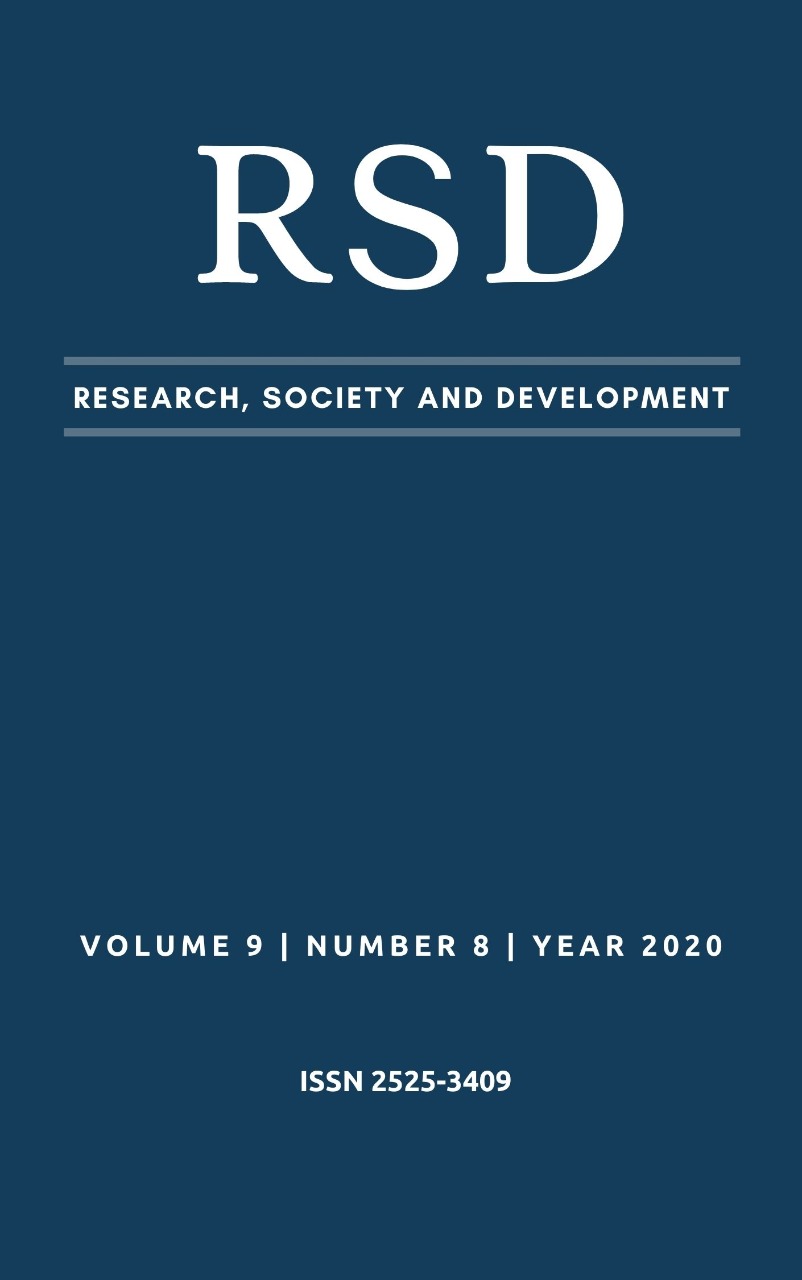Risk factors for stroke in young: a comparison between men and women
DOI:
https://doi.org/10.33448/rsd-v9i8.6503Keywords:
Risk factors; Stroke; Young adult; Women's health; Men's health.Abstract
Objective: To analyze the risk factors for stroke in young men and women. Method: Cross-sectional, quantitative study, carried out with 1073 young adults. Data were collected using a form and, to associate risk factors with sex, the chi-square and odds ratio were used. To adjust the model, logistic regression was used. Results: Women reported more stroke in the family than men, higher level of physical inactivity and had higher cholesterol levels, as well as a higher proportion of them were on an unbalanced diet; in turn, men reported more smoking and alcohol use and more altered blood glucose and blood pressure levels. After adjustment, there was a significant association between sex and: smoking, cholesterol classification, blood pressure and excess weight. Conclusion: Men had more smoking and more pre-hypertension / hypertension and women had higher levels of cholesterol and excess weight.
References
Araujo, L.P.G., Souza, G.S., Dias, P.L.R.,& Nepomuceno, R.M.(2017). Principais fatores de risco para o acidente vascular encefálico e suas consequências: uma revisão de literatura. Rev Inter do Pens. Cientif, 1(3), 283-293.
Barbosa, F.D.J., Barros, C.T.L., Silva, G.A., Melo, J.G.,& Santos, E.F.S.(2014) Recuperação após Acidente Vascular Cerebral em adulto jovem submetido à fisioterapia alternativa. Rev Inter: Saú, Human e Tecno, 2(6),1-3.
Bergamo, F.P.M.S., Segri, N.J., Barros, M.B.A.,& Malta, D.C.(2015). Desigualdades sociodemográficas nos fatores de risco e proteção para doenças crônicas não transmissíveis: inquérito telefônico em Campinas, São Paulo. Epidemiol. Serv. Saúde, 24(1), 07-18.
Correia, J.P., Figueiredo, A.S., Costa, H.M., Barros, P.,& Veloso, L.M.(2018). Investigação Etiológica do Acidente Vascular Cerebral no Adulto Jovem. Medicina Interna, 25(3), 213-223.
Florêncio, R.S., Moreira, T.M.M., Silva, M.R.F., & Almeida, I.L.S.(2016). Overweight in young adult students: the vulnerability of a distorted selfperception of body image. Rev. bras. enferm, 69(2), 258-65.
Florêncio, R.S., Santiago, J.C.S., Moreira, T.M.M.,& Freitas, T.C.(2016). Excessive weight and sociodemographic vulnerability markers in Young adult students. Acta Paul. Enferm, 29(4), 413-20.
Henrique, M., Henrique, J.,& Jacinto J. (2015). Acidente Vascular Cerebral no Adulto Jovem: A Realidade num Centro de Reabilitação. Rev. da Soc Portug de Med. Fís e de Reabilit, 27(1).
Lima, M.J.M.R., Moreira, T.M.M., Florêncio, R.S.,& Braga, N.P.(2016). Fatores associados ao conhecimento dos adultos jovens sobre histórico familiar de Acidente Vascular Cerebral. Rev. Latino-Am. Enfermagem, 24:e2814.
Malachias, M.V.B., Souza, W.K.S.B., Plavnik, F.L., Rodrigues, C.I.S., Brandão, A.A., Neves, M.F.T., et al.(2016). 7ª Diretriz Brasileira de Hipertensão Arterial. Arq Bras Cardiol,107(3Supl.3),1-83.
Maniva, S.J.C.F., Carvalho, Z.M.F., Gomes, R.K.G., Carvalho, R.E.F.L., Ximenes, L.B., Freitas, H.A.(2018). Tecnologias educativas para educação em saúde no acidente vascular cerebral: revisão integrativa. Rev. Bras. Enferm, 71(Suppl 4),1724-1731.
Marie, N.G., Tom, F.B.S., Margaret, R.B.A., Blake, T.B.A., Nicholas, G.B.S., Christopher, M.B.S., et al.(2013). Global, regional, and national prevalence of overweight and obesity in children and adults during 1980–2013: a systematic analysis for the Global Burden of Disease Study 2013. The Lancet, 384(9945),766-781.
Ministério da Saúde (BR).(2017). AVC: Causas, Sintomas, Tratamentos, Diagnóstico e Prevenção.Brasília: Ministério da Saúde. Available from: http://portalms.saude.gov.br/saude-de-a-z/acidente-vascular-cerebral-avc .
Pan, B., Jin, X., Jun, L., Qiu, S., Zheng, Q.,& Pan, M.(2019).The relationship between smoking and stroke: a meta-analysis. Medicine (Baltimore), 98(12):e14872.
Pereira, T.M.A., Silva, J.M., Teixeira, S.,Orsini, M.,& Bastos, V.H.V. (2019) Avaliação do perfil dos fatores de risco para Acidente Vascular Cerebral: estudo observacional. Rev. Pesqui. Fisioter, 9(1), 37-44.
Pingsen, Z., Sudong, L., Zhixiong, Z.,& Jing, L. (2018). Age- and sex-related difference of lipid profile in patients with ischemic stroke in China. Medicine, 97(23), e10930.
Rodrigues, M.,Santana, L.F.,& Galvão, I.M.(2017). Fatores de risco modificáveis e não modificáveis do AVC isquêmico: uma abordagem descritiva. RevMed, 96(3),187-92.
Santos, A.M., Porelli, J.P., Jesus, K.E.M.,& Santos, I.F.M. (2018). Fatores de risco para hipertensão em jovens universitários. Rev. Ciênc. Méd. Biol, 17(1), 52-60.
Scherr, C., Castro, F.L.C.,Guerra, R.L., Belém, L.H.J., Câmara, A.,C.,G.,& Campos, A.(2018). Práticas Esportivas e Risco Cardiovascular em Adolescentes. Arq. Bras. Cardiol, 110(3), 248-255.
Downloads
Published
How to Cite
Issue
Section
License
Copyright (c) 2020 Elis de Souza Albuquerque, Raquel Sampaio Florêncio, Thereza Maria Magalhães Moreira, Suelane Cristina Silva de Lima, Samuel Miranda Mattos, Danilo Cunha Ribeiro

This work is licensed under a Creative Commons Attribution 4.0 International License.
Authors who publish with this journal agree to the following terms:
1) Authors retain copyright and grant the journal right of first publication with the work simultaneously licensed under a Creative Commons Attribution License that allows others to share the work with an acknowledgement of the work's authorship and initial publication in this journal.
2) Authors are able to enter into separate, additional contractual arrangements for the non-exclusive distribution of the journal's published version of the work (e.g., post it to an institutional repository or publish it in a book), with an acknowledgement of its initial publication in this journal.
3) Authors are permitted and encouraged to post their work online (e.g., in institutional repositories or on their website) prior to and during the submission process, as it can lead to productive exchanges, as well as earlier and greater citation of published work.

